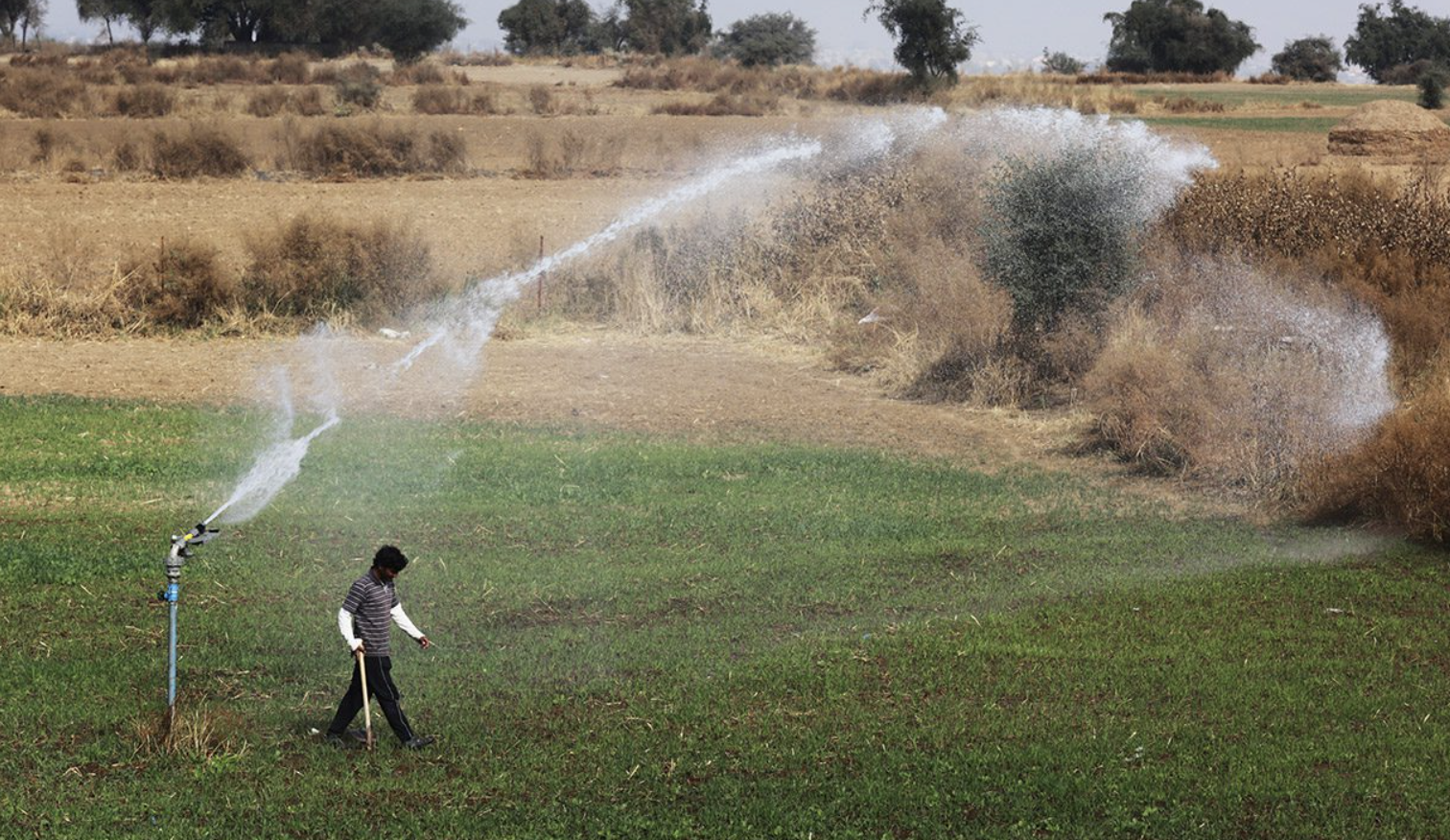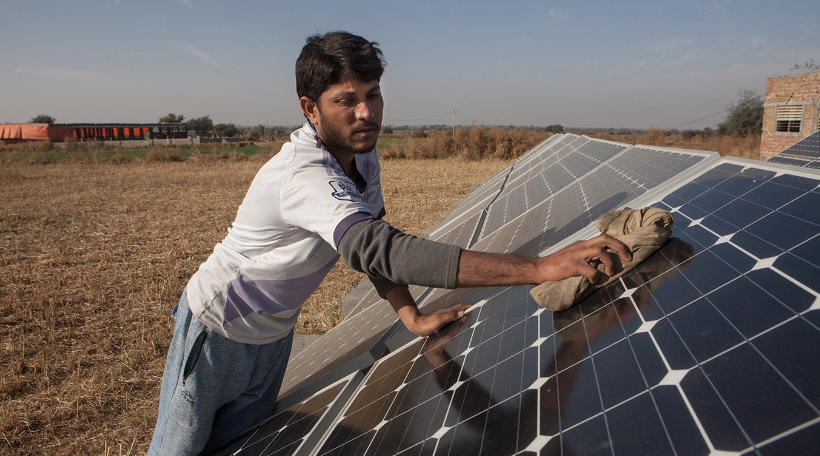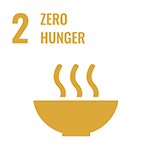Solar powered pumps for irrigation in Pakistan

Summary
Due to increasingly erratic rainfall, farmers in Rawalpindi, Punjab, Pakistan, have been struggling to irrigate their farms. While very little can be done to combat erratic and deficit rainfall, scalable and accessible technologies to enhance irrigation can help farmers meet their agricultural water needs. One such example is the solar pump.
The Hindu Kush Himalaya (HKH) contains the headwaters of ten large Asian river systems, whose basins are the lifeblood of 1.9 billion people, a fourth of the world’s population. In Pakistan, perennial glacier-fed rivers carve through the mountainous regions but mountain farmers lack proper access to sufficient water for irrigation. The rugged, undulating terrain coupled with the lack of irrigation infrastructure makes it difficult to harvest water from the rivers. Downstream, farmers dependent on rainfall for farm irrigation are extremely vulnerable to climate change induced drought and unpredictable rainfall. In the Soan River basin, farmers mostly grow a single type of crop over large areas, and unfavourable rains can destroy the entire season’s crops. Without good irrigation infrastructure, the region’s agricultural productivity and farmers’ incomes are both affected.
To supplement their year-round irrigation water needs, as an alternative, the farmers have turned to rivers and streams that are farther away, or to groundwater. However, the process of pumping water from these sources can be expensive for small and medium sized farms. Buying or renting conventional diesel and electric pumps can be very costly. Moreover, diesel-powered pumps emit large quantities of smoke into the environment.
Overview
- Location:
- Implementation sites:
- Single country
- Multiple locations
- Mountain region:
- Hindu Kush Himalaya
- Solution scale:
- Ecosystem type(s):
- Solution type(s):
- Sector(s):
- Climate impact(s) addressed:
- Impact time-scales:
- Benefits:
- Co-benefits:
- Implementation timeline:
- 2023 - 2023
- Sendai targets:
Solution details
Main beneficiaries & outcomes
The pilot in Chakri village has received widespread attention and appreciation in the Rawalpindi region. Government officials, researchers, and the community have expressed interest in adapting the technologies and practices in their own areas as well.
The solar pumps and the climate-smart practices has allowed farming in Chakri village to become more sustainable in the face of climate change and water scarcity. Better water management has further allowed farmers to diversify their production by growing off-season crops. In the longer-run, the pumps are expected to improve farm production, soil nutrients and crop diversity.
The ‘portability’ of solar pumps allows large-scale farmers flexibility to increase irrigated area by 3–4 times. The adoption of HEIS has enabled water saving for small farmers in a water stressed context and enabled them to double their cropping area. Increased crop diversification has led to improved resilience in the face of climate-induced changes, through multiple income sources. Small farmer’s incomes have increased by 3–4 times as well.
The solar pumps also reduce the time and effort required to collect water, thus benefitting women in the region who are often tasked with this.
Planning and implementation
To address the challenge in Rawalpindi, the Pakistan Agriculture Research Council (PARC), under the HI-AWARE Initiative, piloted Solar Pumping Irrigation Systems with climate-smart practices. Based on a situational analysis and discussions with local farmers in Chakri, a medium sized farm up to 15 acres that is distributed on both sides of the Soan river has been selected. This farm was converted into a learning and training site for other farmers, researchers, and professionals, with an aim to promote the use of new technologies and practices. Primarily, the pilot was designed to introduce more affordable and environmentally friendly solar-powered pumps to farming communities.
Solar powered pumps:
- are affordable
- do not rely on electricity
- allow efficient extraction of water
- are multipurpose
A solar powered water pump has an electrical pump system in which electricity is provided by one or several solar panels that powers an electric motor, which in turn powers a bore or surface pump. The water is pumped from the ground or stream into a storage tank that then allows for gravity-fed irrigation.
Farmers can have access to water throughout the year as the pump is designed to keep in mind the rate of discharge, total available sunshine hours, and potential evapotranspiration. It can either be fixed in a certain location or made portable to be shared by several farmers. Solar pumps also allow the use of drip irrigation and micro sprinklers, allowing the water extracted to be used more efficiently.
Furthermore, solar pumps reduce the reliance on fuel and electricity for farming and other purposes. They can be used as a power source for geysers to heat water, for energy-efficient cookstoves and to power lights or other equipment to help farms run more sustainably. The pumps can also be used in places with unreliable electricity or in areas outside the electrical grid coverage.

The solar-powered water pumping system was designed to enable water to be pumped from rivers or open surface water bodies. It can also withdraw water from dug wells in riverine areas where water recharge is sustainable. Importantly, the pumped water is used with a high-efficiency irrigation system (which was not the case earlier), which helps to better utilize water that was previously being used inefficiently using diesel pumps and animal-driven Persian wheels.
Finance
The price of the system at present is around PKR 800,000 (USD 6,000 approximately). The introduction of compact and integrated panels, and economies of scale may lower this cost in the future.
Innovation
This solution applied new, innovative technologies to create a more sustainable and resilient water management approach in the agricultural sector. The solar-powered pumping system was designed to enable water to be pumped from rivers or open surface water bodies and to withdraw water from dug wells in riverine areas where water recharge is sustainable. This reduces the farmers’ and local communities’ dependency on dug wells and groundwater availability which is impacted by erratic rainfall patterns and the varying lengths of dry spells.
Capacities for design and implementation
Knowledge
HI-AWARE–PARC conducted nearly 49 trainings for farmers and professionals so that they fully understand the maintenance and operation mechanisms of the portable solar pumping system as well as CSA. This ensured that the small farmer communities would be self-sufficient in the system’s operation and maintenance.
Socio-cultural
The pilot farm was selected based on discussions with local farmers in Chakri. The farmer included in the pilot was willing to accept the introduction of new technology and agriculture production practices on his farm. He was also willing to collect data in partnership with the project team, make investments in innovative farm practices (i.e., tunnel farming, sprinkler system, drip irrigation etc) and use the pilot farm as a training site for other farmers in the nearby village for practitioners, researchers, and media to see. Thus, the solution required engagement with local communities to successfully understand how to meet the needs of farmers in the region, and for effective cooperation going forwards.
Outlook & Scalability
Barriers and adverse effects
The pilot was more policy oriented and less focused on the adoption of the technologies by other farmers, and thus it cannot be termed a community model. Unless the community is involved, it becomes difficult to evaluate adoption by other farmers or the relevance and comparative advantage of the pilot itself. Furthermore, the continuous use of the set of technologies will require adequate awareness, technical knowledge, and access to technology among the farmers, which is currently poor.
Potential for upscaling and replication
Based on HI-AWARE’s extensive work on solar water pumps, the Federal Government launched “Prime Minister’s support program for farmers for solar tube wells” and invited two experienced members of the HI-AWARE team to lead policy formulation. The International Fund for Agricultural Development (IFAD) has sought technical support from HI-AWARE for a forthcoming project in Gilgit–Baltistan worth PKR 12 billion, under which 50,000 acres of barren land will be converted to agricultural land. The experience and success of the pilot will be used to reinforce climate smart agriculture in the National Climate Change Policy.
Related resources
- Himalayan Adaptation, Water and Resilience Research on Glacier and Snowpack Dependent River Basins for Improving Livelihoods
- Inter-regional Project for Participatory Upland Conservation and Development (PUCD)
- As good as new: Rehabilitating irrigation systems in Gajimarda, Azerbaijan
- Guiding water flows - The Project for the Development of Irrigation System in the Atari Basin Area in Uganda
- Improvement of 3 irrigation channels incorporating climate change adaptation measures in Andean ecosystems


(0) Comments
There is no content